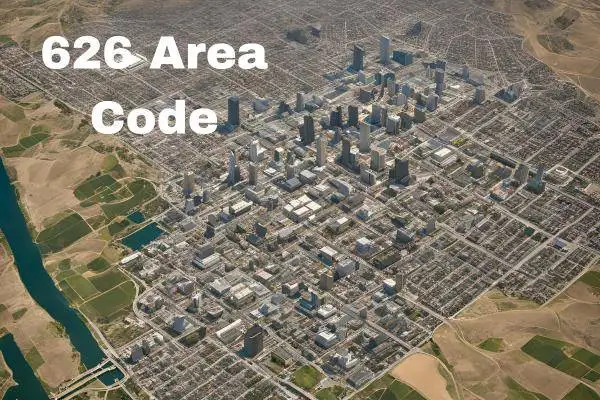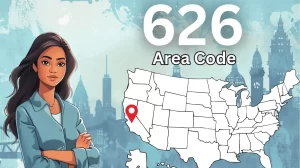The 626 area code is more than just a collection of digits. It serves as the communication backbone for a culturally rich and economically vibrant part of Southern California. Covering parts of the San Gabriel Valley, including cities like Pasadena, Alhambra, and Arcadia, the 626 area code is steeped in history, diversity, and progress. In this article, we’ll explore the significance of the 626 area code, from its origins to its cultural, economic, and technological impact.
Table of Contents
History of the 626 Area Code
The 626 area code came into existence on June 14, 1997, following a split from the 818 area code. The change was necessary due to the rapid increase in demand for phone numbers in the Los Angeles metropolitan area, particularly the San Gabriel Valley. This demand was fueled by the region’s population growth and the expansion of businesses that required additional phone lines.
Prior to the split, the San Gabriel Valley relied on the 818 area code, which was quickly becoming overburdened. The introduction of the 626 area code provided much-needed relief, allowing for continued growth and communication in the region. Over the years, has become synonymous with the communities it serves, playing a pivotal role in shaping their identity.

Cities and Regions Covered by the 626 Area Code
The 626 area code encompasses a variety of cities and regions within the San Gabriel Valley. Some of the most notable cities include:
- Pasadena: Known for its historic landmarks, such as the Rose Bowl and the annual Rose Parade, Pasadena is the largest city. It is also home to major research institutions like the California Institute of Technology (Caltech).
- Alhambra: This city is famous for its rich cultural diversity, particularly its vibrant Asian-American community. Alhambra boasts a thriving restaurant scene and numerous cultural festivals.
- Arcadia: Known for the Los Angeles County Arboretum and the Santa Anita Park racetrack, Arcadia offers a blend of suburban living and natural beauty.
- Monterey Park: Often referred to as the “First Suburban Chinatown,” Monterey Park has a strong Chinese-American presence and is a hub for Asian cuisine and businesses.
- El Monte: A more industrial part of the valley, El Monte plays a key role in the region’s economic landscape with its manufacturing and transportation industries.
These cities, along with others in the San Gabriel Valley, contribute unique identity—one that blends suburban charm with urban dynamism, all while celebrating a rich cultural tapestry.
Cultural Significance of the 626 Area Code
The 626 area code holds deep cultural significance, particularly among the Asian-American community. Cities like Monterey Park and Alhambra are renowned for their Asian influences, evident in the architecture, cuisine, and local businesses. This region has become a melting pot of different cultures, particularly Chinese, Vietnamese, and Filipino communities, which have helped shape its identity.
One of the most significant aspects of the 626 area code is its role as a food hub. The San Gabriel Valley is often regarded as one of the best places in the U.S. for authentic Asian cuisine. Whether you’re looking for dim sum, pho, or hot pot, the restaurants in the 626 area code have something to offer every palate.
In recent years, the 626 area code has also become a social media sensation, particularly due to events like the 626 Night Market. This large-scale, nighttime food market attracts visitors from across the region, offering a wide range of street food, beverages, and entertainment. Events like these highlight the area code’s vibrant, multicultural atmosphere and further cement its place in Southern California’s cultural landscape.
Economic Impact of the 626 Area Code
The 626 area code is not just culturally rich—it also plays a significant role in the economy of Southern California. The region covered by the 626 area code is home to a variety of industries, including healthcare, education, manufacturing, and retail.
- Healthcare: The 626 area is home to several major healthcare institutions, including Huntington Hospital in Pasadena. The presence of healthcare facilities supports a large workforce, contributes to the local economy, and attracts professionals to the region.
- Education: Institutions like Caltech and Pasadena City College are located, drawing students from around the world. These institutions not only contribute to the academic prestige of the region but also serve as major employers.
- Small Businesses: There is dotted with small businesses, from family-owned restaurants to specialty shops. Many of these businesses cater to the local community while also drawing visitors from across Southern California. The area’s thriving food and retail scenes are particularly vital to its economy.
As the continues to grow, so does its economic impact. The blend of established industries and entrepreneurial ventures makes it an essential part of Southern California’s financial landscape.
Technology and Communication in the 626 Area Code
As technology continues to evolve, so has communication within the 626 area code. With the rise of smartphones, the need for traditional landlines has diminished, but the demand for mobile phone numbers has surged. The 626 area code has adapted to this technological shift, ensuring that residents and businesses alike have access to the communication services they need.
In addition to traditional phone lines, has seen a rise in the use of Voice over Internet Protocol (VoIP) services, which allow people to make phone calls via the internet. This shift has further increased the demand for numbers in the area, prompting telecommunications providers to implement more efficient number allocation methods.
While has managed to keep up with the region’s growing population and technological needs, future changes may be necessary. If the demand for phone numbers continues to rise, it’s possible that new area codes could be introduced or that overlay area codes could be implemented to ensure there are enough numbers for everyone.

The Future of the 626 Area Code
The 626 area code remains a vibrant part of Southern California, but like all area codes, it faces potential changes in the future. With the ongoing expansion of mobile technology, demand for new phone numbers is expected to continue growing. As a result, there may come a time when the 626 area code reaches its capacity.
In response to this potential issue, telecommunications companies may consider adding an overlay code, where new phone numbers in the same geographic region would receive a new area code. Alternatively, the area code could be split again, as it was from the 818 area code in 1997. Either way, will continue to serve the communities and businesses of the San Gabriel Valley.
However, despite potential changes, will always be a symbol of local pride. It represents the unique blend of cultures, industries, and lifestyles that make the San Gabriel Valley such a dynamic and exciting place to live and work.
Why the 626 Area Code is More Than Just a Number
The 626 area code is more than just a set of digits assigned to phone numbers. It represents a region with a rich cultural heritage, a thriving economy, and a diverse population. For the residents and businesses of the San Gabriel Valley, the 626 area code is a source of local pride and identity.
From its historical significance as a solution to the growing need for phone lines to its current role as a cultural and economic hub, it has made a lasting impact on Southern California. Whether you’re a resident, a visitor, or a business owner, there is an essential part of the fabric of the San Gabriel Valley.
Conclusion
The 626 area code continues to be a central part of California’s San Gabriel Valley, representing both its rich history and its forward-thinking future. Its significance goes beyond communication, symbolizing the cultural diversity and economic vitality of the region. Whether you’re dining at a renowned restaurant in Alhambra or working at a high-tech lab in Pasadena, the connects people, businesses, and communities in more ways than one.
As the population grows and technology advances, the will likely see changes, but it will remain a core part of the identity of the San Gabriel Valley. Its legacy as a hub for innovation, diversity, and progress is sure to endure.

FAQs
1. What is the 626 area code?
The serves part of the San Gabriel Valley in Southern California. It was established in 1997 after a split from the 818 area code due to increased demand for phone numbers.
2. Which cities are covered by the 626 area code?
The covers several cities in the San Gabriel Valley, including Pasadena, Alhambra, Arcadia, Monterey Park, El Monte, and more.
3. When was the created?
The 626 area code was officially created on June 14, 1997, when it was split from the 818 area code to meet the growing demand for phone numbers in the Los Angeles metropolitan area.
4. Why was the introduced?
The introduction of the 626 area code was due to the rapid population growth and increased demand for phone lines in the San Gabriel Valley, which led to the exhaustion of numbers in the 818 area code.
5. What makes the unique?
The 626 area code is known for covering a culturally diverse region with a significant Asian-American population, as well as being home to renowned cities like Pasadena and popular events like the 626 Night Market.






